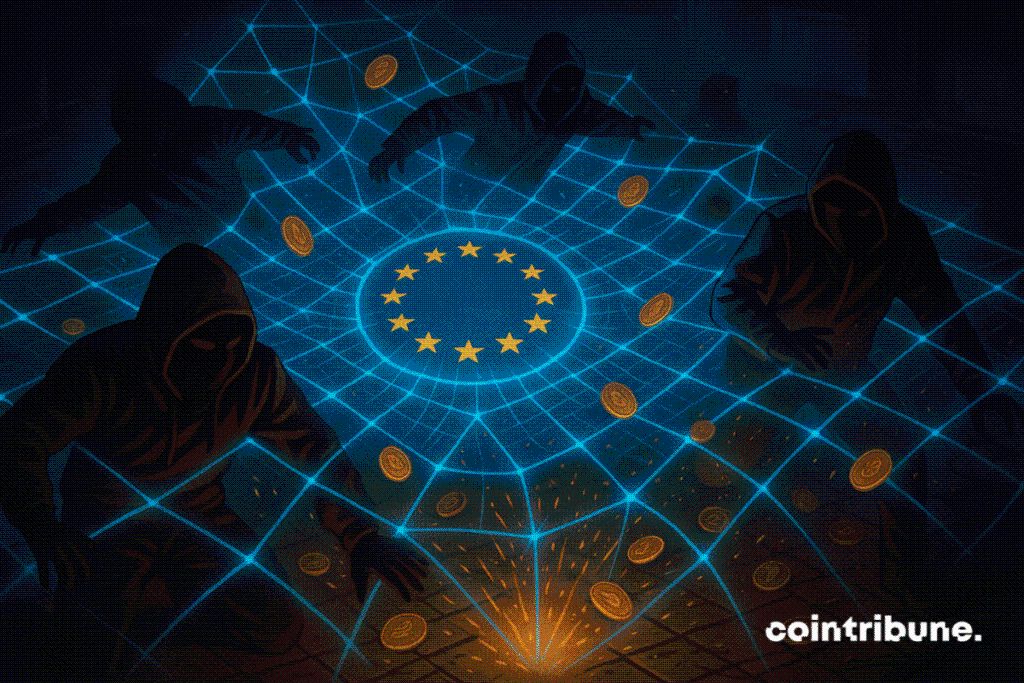Eurojust Leads Joint Action Against Crypto Fraudsters
Europe has just dealt a decisive blow against one of the largest crypto scams ever dismantled. Over 600 million euros embezzled through fake investment platforms, nine arrests in three countries, and an operation conducted swiftly under Eurojust’s coordination. This cross-border crackdown unveils the alarming scale of criminal networks exploiting blockchain to launder funds out of sight. A case that confirms the urgency of a judicial response commensurate with the crypto challenges.

In brief
- A Europe-wide crypto scam enabled a criminal network to embezzle over 600 million euros.
- The fraudsters set up fake investment platforms promising high returns with a professional appearance.
- Victims were recruited through targeted ads, fake testimonials, misleading articles, and cold calls.
- The stolen funds were laundered using blockchain, making financial flows hard to trace.
Fraudulent platforms serving a 600 million euro scam
While the ECB steps up efforts towards the digital euro , a network of fraudsters has just been dismantled. The investigation reveals a sophisticated scam system set up by an international network that embezzled over 600 million euros through fake crypto investment sites. Designed to mimic legitimate platforms, these digital interfaces offered staggering returns to attract savers.
Eurojust states : “members of the network created dozens of fake crypto investment platforms that looked like legitimate sites and promised high returns.” Once involved, victims could never recover their transferred funds.
To reach their targets and lend credibility to their platforms, the fraudsters used a well-honed arsenal of manipulation methods :
- Targeted advertisements on social networks to reach unsuspecting investors ;
- Cold phone calls by operators posing as financial advisors ;
- Fake press articles manufactured to simulate positive media coverage ;
- Invented or hijacked celebrity testimonials used to inspire trust ;
- Promises of unrealistic returns designed to trigger quick payments.
The collected money was then laundered via blockchain, making financial flows difficult to trace. This technique concealed a large part of the cryptos from the fraud. Complaints from victims unable to withdraw their funds first alerted French and Belgian authorities, who initiated the joint investigation.
The case, of exceptional scope, illustrates the rise of large-scale crypto scams and the high level of technological sophistication now reached by certain criminal groups.
A coordinated dismantling : the transnational judicial response orchestrated by Eurojust
The credit goes to Eurojust, the European Union Judicial Cooperation Agency, for catalyzing an unprecedented joint response to this sprawling crypto scam.
The investigation, initiated through initial collaboration between French and Belgian authorities, led to the formation of a joint investigation team, soon expanded to Germany, Spain, and Cyprus. “Eurojust enabled authorities to collaborate quickly and efficiently,” the statement highlights, also mentioning that actions were coordinated from The Hague on October 27 and 29, 2025.
The simultaneous arrests of nine suspects at their homes in Germany, Spain, and Cyprus were carried out discreetly and precisely, with support from specialized cybercrime units such as the French National Gendarmerie, the Cologne Criminal Police, and the Spanish Mossos d’Esquadra. During searches, investigators seized 800,000 euros in bank accounts, 415,000 euros in cryptos (bitcoin and other assets), and 300,000 euros in cash, confirming the financial scale of the operation.
Beyond its immediate effectiveness, this dismantling marks an important step in pan-European response capacity to financial abuses linked to cryptos. Eurojust’s intervention illustrates a strengthened willingness to cooperate beyond borders to neutralize transnational networks exploiting technological and regulatory gaps in the sector. While the case currently ends with arrests, it also lays the groundwork for a more systematic and proactive judicial approach going forward. As crypto investments become democratized, this operation could well serve as a model of action against constantly evolving crime.
Disclaimer: The content of this article solely reflects the author's opinion and does not represent the platform in any capacity. This article is not intended to serve as a reference for making investment decisions.
You may also like
Aster News Today: CZ's ASTER Surge Sparks Intense Bull and Bear Showdown at the $1.29 Threshold
- Binance's CZ triggered a 40% ASTER token surge via a $2.5M purchase, but the altcoin later corrected 15% amid classic "pump and dump" dynamics. - Whale entities netted $7.7M from short positions as ASTER's $1.25 peak collapsed, highlighting crypto's volatility and speculative risks. - CZ defended decentralized market mechanics while analysts noted ASTER's critical $1.29 breakout threshold amid broader crypto turbulence and regulatory pressures.

"Chainlink and SBI Facilitate Safe and Regulatory-Compliant Cross-Chain Transfers of Tokenized Assets"
- Chainlink partners with SBI Digital Markets to enhance cross-chain interoperability for tokenized assets using CCIP. - The integration enables secure, private transactions and compliance automation, supporting institutional-grade digital asset operations across public and private blockchains. - This collaboration builds on prior projects with UBS and aligns with Japan’s regulatory openness, aiming to redefine institutional blockchain adoption in Asia and Europe. - Upcoming Chainlink tools like CRE and Co

ZEC briefly touched $510, with a 24-hour increase of 17.11%.
